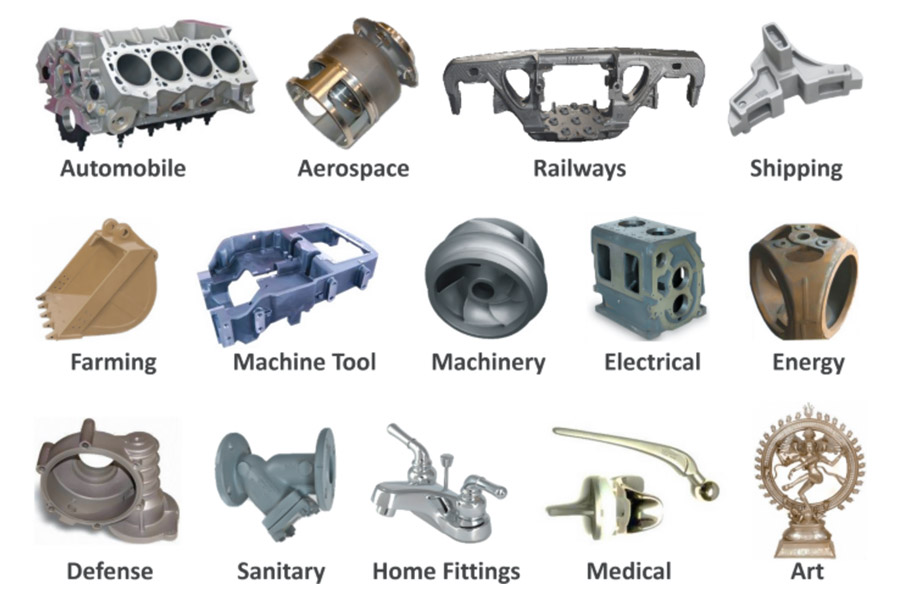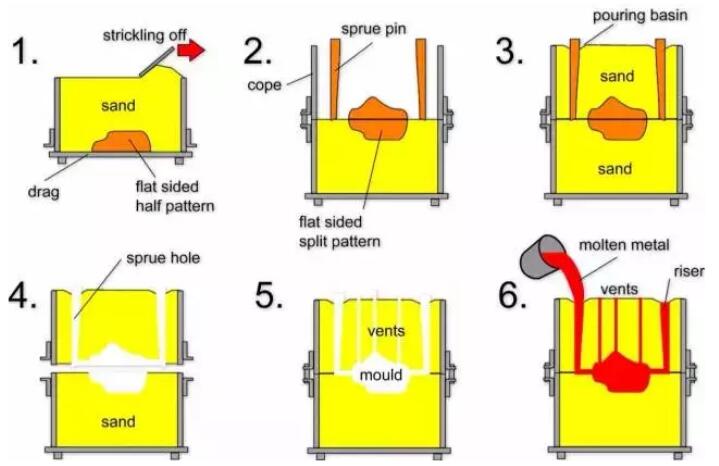Recognizing the Steel Castings Process: A Comprehensive Guide for Beginners
The Metal Casting procedure is a fundamental strategy in making that transforms molten metal right into solid kinds. Beginners need to realize the numerous approaches involved, such as sand casting and die casting. Recognizing the materials, layout principles, and security steps is just as important. Each element plays a critical duty in accomplishing effective end results. As one navigates these details, the inquiry of just how to enhance each action for boosted results comes to be significantly relevant.
The Fundamentals of Steel Casting
Metal Casting has progressed over centuries, its basic principles continue to be indispensable and consistent to the manufacturing process. At its core, Metal Casting involves the improvement of liquified metal into strong objects through different methods. The procedure starts with the development of a mold, which specifies the shape of the end product. When the mold and mildew is prepared, steel is heated to its melting point and poured into the dental caries. After cooling down, the steel strengthens, taking the shape of the mold.
There are several casting methods, including sand casting, financial investment spreading, and pass away spreading, each with unique benefits and applications. The selection of technique relies on factors such as manufacturing volume, product kind, and wanted precision. As soon as cast, the end product might undergo additional procedures like machining or surface therapy to attain the needed coating and requirements. Comprehending these basics is necessary for any individual interested in the field of Metal Casting.

Recognizing Materials Made Use Of in Steel Casting
Materials play a vital duty in the Metal Casting process, influencing the last product's homes and efficiency. Numerous metals are used, consisting of aluminum, steel, bronze, and iron, each offering distinctive attributes matched for specific applications. Aluminum is corrosion-resistant and light-weight, making it optimal for auto parts. Iron, specifically cast iron, is preferred for its excellent wear resistance and toughness. Steel gives high stamina and flexibility, often used in hefty machinery components. Bronze, known for its rust resistance and machinability, is typically used in marine applications.
Along with the metals, various casting materials, such as sand, plaster, and ceramic, are used to produce mold and mildews. Sand casting, the most prevalent method, uses silica sand as a result of its thermal security and capacity to create intricate shapes. Plaster and ceramic molds provide finer details yet might call for more complex processes. The option of materials directly influences the efficiency, price, and top quality of the casting procedure.
The Layout Process: From Principle to Plan
The style process in Metal Casting begins with the initial concept growth, where ideas are produced and examined. This is complied with by the application of CAD modeling techniques, permitting exact visualizations of the design. The plan finalization actions ensure that all requirements are accurately documented for production.
Preliminary Concept Advancement
Initial principle development notes a vital stage in the Metal Casting procedure, where ideas change right into tangible layouts. Throughout this stage, designers work together with stakeholders and designers to brainstorm and improve preliminary concepts. They take into consideration variables such as performance, appearances, and manufacturability, making sure that the design satisfies the needed requirements and performance requirements. Sketches and outlines are created to picture the concepts, permitting initial assessments of expediency and cost-effectiveness. This stage also entails recognizing materials and possible casting methods that line up with the design goals. Ultimately, first principle growth prepares for a thorough plan, directing the subsequent phases of the spreading process and making certain an effective shift from concept to reality.
CAD Modeling Techniques
Changing principles right into exact layouts, CAD modeling strategies play a critical function in the Metal Casting process. These methods utilize advanced software application to develop comprehensive three-dimensional designs that precisely show the desired item. By using tools such as parametric modeling, solid modeling, and surface modeling, developers can control measurements and forms with ease. CAD systems likewise facilitate simulation and analysis, enabling the identification of potential defects before manufacturing begins. This proactive approach reduces product waste and optimizes the layout for manufacturability. Additionally, CAD versions can be easily customized, allowing quick iterations based upon feedback. Essentially, CAD modeling functions as the foundation of the design procedure, connecting the space between first ideas and the ultimate production-ready layouts.
Plan Completion Tips
Complying with the development of comprehensive CAD versions, the following phase involves plan finalization, which is vital in converting electronic layouts right into workable strategies for manufacturing. This process begins with assessing the CAD designs for accuracy and conformity with requirements. As soon as verified, the dimensions, tolerances, and product requirements are thoroughly detailed to guarantee clarity. Including notes and notes assists communicate important information concerning spreading procedures, surface area finishes, and assembly demands. The completed plan undergoes a rigorous approval process, commonly involving collaboration with engineers and manufacturing groups to address any type of possible issues. After all alterations are made and approvals gotten, the blueprint is formally released, acting as the foundational paper for the succeeding stages of Metal Casting, including pattern making and mold and mildew style.
The Metal Casting Strategies Clarified

Metal Casting techniques include a range of approaches made use of to form molten metal right into desired types. These techniques differ according to the kind of product, complexity of the design, and manufacturing volume. Sand casting is among the most common methods, involving the creation of a mold and mildew from sand to hold the liquified metal. Financial investment casting, or lost-wax spreading, enables for intricate styles by utilizing a wax pattern that is thawed away. Pass away casting employs high-pressure shot of molten metal right into a mold and mildew, appropriate for automation. Various other techniques consist of permanent mold and mildew spreading, which uses multiple-use mold and mildews, and centrifugal casting, where rotational pressures assist in filling up the mold and mildew. Each strategy has its advantages and applications, making it important for manufacturers to choose the proper method based useful content upon their specific demands and demands. Understanding these techniques is vital for anybody entailed in the Metal Casting process.
Ending Up Processes: Enhancing Your Casted Product

Ending up processes play an important function in enhancing the quality and look of casted products. Numerous surface area therapy strategies, such as polishing and coating, are employed to improve durability and looks. Furthermore, quality assessment methods assure that the end product meets defined standards and efficiency requirements.
Surface Area Treatment Strategies
A range of surface area treatment techniques play a necessary duty in improving the quality and longevity of casted items. These techniques consist of methods such as shot blasting, polishing, and finishing. Shot blasting efficiently removes surface area blemishes, enhancing the aesthetic and functional features of the casting. Sprucing up offers a smooth coating, which is especially important for ornamental applications and parts requiring very little rubbing. Layer methods, such as electroplating or powder finishing, deal additional defense against deterioration and wear, ensuring toughness. Surface area therapies can enhance adhesion for subsequent processes, such as paint or bonding. By using these methods, suppliers can accomplish premium surface top quality, which is critical for the performance and lifespan of Metal Casting in various applications.
Quality Evaluation Techniques
Reliable quality assessment approaches are essential for guaranteeing the integrity and performance of casted items after the ending up procedures. Different strategies are utilized to examine the quality of Metal Casting, consisting of aesthetic assessment, dimensional checks, and non-destructive testing (NDT) Aesthetic inspection permits the identification of surface defects, while dimensional checks guarantee that items satisfy defined tolerances. NDT techniques, such as ultrasonic screening and radiographic inspection, offer deeper understandings right into inner integrity without harming the castings. Furthermore, mechanical testing, such as tensile and hardness examinations, assesses material buildings - Aluminum Castings. By utilizing a mix of these methods, suppliers can boost product high quality and reliability, inevitably causing higher customer satisfaction and reduced production costs
Safety Considerations in Metal Casting
While the Metal Casting process offers numerous benefits, it likewise offers a variety of safety risks that must be meticulously managed. Workers in casting facilities are revealed to heats, liquified metals, and hazardous materials, which can bring about severe injuries if proper preventative measures are not taken. Individual protective tools (PPE) such as heat-resistant gloves, encounter guards, and protective clothes is essential to decrease dangers.
In addition, the visibility of fumes and dust demands appropriate ventilation systems to assure air high quality - Aluminum Foundry. Routine training on safety methods is crucial for all workers to recognize possible dangers and react properly. Emergency situation treatments ought to be established, consisting of fire safety steps and emergency treatment accessibility. Upkeep of equipment and correct handling of materials further contribute to a safer working environment. By focusing on these security factors to consider, Metal Casting procedures can safeguard their labor force and keep effective manufacturing processes
Regularly Asked Questions
What Are the Ecological Effects of Metal Casting?
Metal Casting can cause environmental effects such as air and water air pollution, resource deficiency, and power consumption. Additionally, incorrect waste administration and exhausts from factories add find out this here to ecological disturbances and click site wellness risks for nearby neighborhoods.
Just how Do I Pick the Right Metal for Casting?
To choose the best metal for spreading, one need to take into consideration aspects such as mechanical residential properties, deterioration resistance, thermal conductivity, and cost. Evaluating the designated application and environmental problems is essential for ideal option.
What Are the Usual Defects in Metal Casting?
Typical problems in Metal Casting include porosity, shrinkage, sand addition, and misruns. These issues often occur from inappropriate material option, inadequate style, or defects in the casting procedure, influencing the final product's high quality and efficiency.
How Can I Boost My Metal Casting Skills?
To enhance Metal Casting abilities, one should practice regularly, research casting techniques, assess previous jobs for issues, look for comments from experienced wheels, and continuously experiment with different products and approaches to boost proficiency and understanding.
What Is the Cost of Starting a Steel Spreading Service?
Beginning a steel spreading organization usually needs a first financial investment of $5,000 to $50,000, relying on equipment, products, and center prices. Variables like area and scale can substantially influence total start-up expenditures.
The Metal Casting process is a fundamental technique in manufacturing that changes molten steel right into strong types. Newbies need to comprehend the different methods entailed, such as sand spreading and die casting. There are a number of casting techniques, consisting of sand casting, investment spreading, and pass away spreading, each with one-of-a-kind benefits and applications. Investment spreading, or lost-wax spreading, permits for elaborate designs by using a wax pattern that is thawed away. Other techniques consist of long-term mold casting, which uses recyclable mold and mildews, and centrifugal casting, where rotational pressures assist in filling up the mold and mildew.